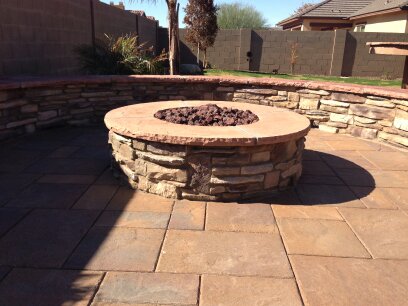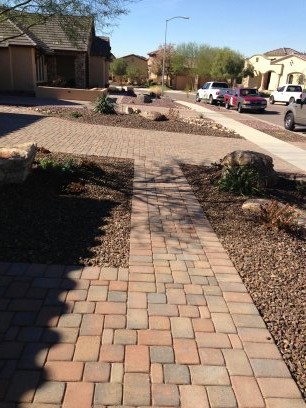How does the cost and durability of Pavers compare to Stamped Concrete or regular concrete slab?
There is more to know when choosing a pavement material than just what meets the eye. While stamped concrete may initially achieve a look that is somewhat similar to pavers, poor durability and difficulty in making repairs have a dramatic impact not only on the appearance, but also on the actual cost in the long term.
 As a conscientious homeowner, you want your driveway, patio, walkways, or pool deck to stand up to the weather, require little maintenance, and look like new for a long time to come. You also want them to be cost-effective. That’s why the popularity of pavers (also referred to as “paving stones” and “brick pavers”) is sky-rocketing. The unrivaled beauty, easy upkeep, and long-term cost efficiency of properly executed paving stone installations are becoming more and more apparent to homeowners.
As a conscientious homeowner, you want your driveway, patio, walkways, or pool deck to stand up to the weather, require little maintenance, and look like new for a long time to come. You also want them to be cost-effective. That’s why the popularity of pavers (also referred to as “paving stones” and “brick pavers”) is sky-rocketing. The unrivaled beauty, easy upkeep, and long-term cost efficiency of properly executed paving stone installations are becoming more and more apparent to homeowners.
Stamped Concrete
“Stamping” concrete is a common way of trying to achieve the attractive patterns associated with actual paving stone material. The stamping is done after the concrete has been poured and before it begins to harden. Stamped concrete is usually tinted (colored) before it is poured. There are standard colors that can be added to the concrete as it goes into the truck.
Unfortunately, the problems associated with maintaining concrete are compounded with the addition of pattern and color. Patching cracks with regular gray concrete means creating unsightly scars, while trying to replace a cracked portion of concrete with a new piece that exactly matches in pattern and in color is nearly impossible.
Concrete
Concrete (along with asphalt) has traditionally been one of the most common paving materials used. It’s low cost per square foot makes it the natural choice of many homeowners as it initially seems to be a relatively inexpensive option. In reality, the inevitable cracking of concrete leads to a long-term cost that’s far greater than installing paving stones, without providing any of the benefits pavers offer.
Cracked Concrete Driveway
It is almost inevitable that concrete will crack at some point in time. Common causes of cracking are when the base moves due to heavy loads or settlement, and the fact that concrete tends to shrink over time. Concrete can also crack as a result of the expansion and contraction caused by heat, and other changes in the weather. The reason contractors place joints in concrete pavements and floors is to encourage the concrete to crack in a neat, straight line at the joint. But this doesn’t always happen, and cracks can appear at random anywhere across the surface of the concrete.
 As these cracks form one by one, year after year, it is often difficult to exactly match the color and composition of the original material each time a repair is needed. As such, a concrete surface gets uglier and uglier with each repair. The alternative to repairing the concrete is to replace the entire structure when the cracks become unbearable. By the time it’s dismantled and properly disposed of, it will likely cost eight to eleven dollars per square foot each time you have to replace existing concrete!
As these cracks form one by one, year after year, it is often difficult to exactly match the color and composition of the original material each time a repair is needed. As such, a concrete surface gets uglier and uglier with each repair. The alternative to repairing the concrete is to replace the entire structure when the cracks become unbearable. By the time it’s dismantled and properly disposed of, it will likely cost eight to eleven dollars per square foot each time you have to replace existing concrete!
Advantages of Brick Pavers/ Paving Stone
Interlocking pavers solve all of the problems described above, and are appropriate for any paving application including patios, pool decks, driveways and walkways. Because pavers are individual units or “bricks,” the natural joints between each paver will “give” with pressure, expansion and contraction, eliminating the cracking inherent to conventional asphalt and concrete pavement.
Pavers do not require time to cure. Unlike concrete, which can take 3 to 5 days before being ready for traffic, paver structures can be used immediately after installation.
The high number of joints in the surface facilitates the drainage of water from rain.
If deformation should occur due to shifting of the base, the structure can easily be repaired by removing individual pavers, re-leveling, and then reinstalling the same pavers.
Pavers provide a pool environment that is less slippery, and has the desirable look of natural stone.
Paver patios don’t crack and will stay beautiful for as long as you’re in your home.
if a repair ever does become necessary, pavers are manufactured to be uniform and can therefore easily be replaced without leaving ugly patches or scars.
Installed over a base of sand, pavers actually increase their structural capacity over time. With a minimum rating of 8000 psi, paving stones are one of the strongest paving materials, rivaled only by brick.
